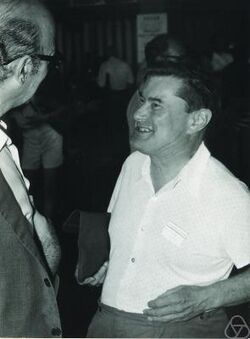Biography:Alexander Aigner
Alexander Aigner | |
|---|---|
 Aigner in discussion (1970). | |
| Born | Graz, Austria-Hungary |
| Died | 2 September 1988 (aged 79) Graz, Austria |
| Citizenship | Austrian |
| Alma mater | Karl Franzens University |
| Known for | Number theory Being one of the original cryptanalysts at the OKW/Chi |
| Scientific career | |
| Fields | Mathematics Physics |
| Institutions | Karl Franzens University |
| Doctoral advisor | Tonio Rella Karl Brauner |
Alexander Aigner (18 May 1909 – 2 September 1988) was a number theorist and a full university professor for mathematics at the Karl Franzens University[1] in Graz. During World War II he was part of a group of five mathematicians, which was recruited by the military cryptanalyst Wilhelm Fenner, and which included Ernst Witt, Georg Aumann, Oswald Teichmueller and Johann Friedrich Schultze, to form the backbone of the new mathematical research department in the late 1930s, which would eventually be called Section IVc of Cipher Department of the High Command of the Wehrmacht. (abbr. OKW/Chi).[2][3] The group was led by the German professor of mathematics Wolfgang Franz.
Life
Alexander Aigner was the son of noted medical doctor Oktavia Aigner-Rollett and anatomist Walter Aigner (1878–1950). He was the grandson of noted physiologist and histologist of Alexander Rollett.[4] He studied mathematics and physics in at the University of Graz. In 1936, he was put forward by Dr. Karl Brauner for promotion to Dr. Phil, with Dr. Tonio Rella advising, with a thesis titled: Mathematical treatment of the hermit game in the plane and in space. About the possibility of [math]\displaystyle{ x^4+y^4=z^4 }[/math] in square bodies (German: Mathematische Behandlung des Einsiedlerspieles in der Ebene und im Raume. Über die Möglichkeit von [math]\displaystyle{ x^4+y^4=z^4 }[/math] in quadratischen Körpern).[5][1] He was offered a position as assistant at the 2nd Chair (Lehrkanzel) for Mathematics at Karl Franzens University. Aigner published articles in the journal Deutsche Mathematik. During World War II, he was recruited along with a number of other mathematicians to make up the backbone of a new cipher bureau for the German Army. He would eventually work at the mathematical research department IV/Section IVc of OKW/Chi under Erich Hüttenhain in the deciphering of complex foreign encryption systems.[2][3]
In 1947 he qualified as a professor at the Karl Franzens University in Graz, where he received an assistant position from Georg Kantz. In 1957, he became an extraordinary professor (Academic ranks in Germany) and finally a full professor. Even after becoming professor emeritus in 1979 he continued to give lectures about number theory, his primary focus. In addition to his professional activities, he also developed a literary interest. He was a member of the Styrian Writers' Union and the confederation of Styrian home poets. After two volumes of poetry, in 1978 he published a collection of cheerful mathematical poems titled Tangents to the Frohsinn (Tangenten an den Frohsinn), a special edition of the reports of the Mathematical-Statistical Section at the Research Center Graz.
Publications
- Kriterien zum 8. und 16. Potenzcharakter der Reste 2 und -2, Deutsche Mathematik, Vol. 1939, p. 44.
- Mathematische Behandlung des Einsiedlerspieles in der Ebene und im Raume, Deutsche Mathematik, Vol. 1940, p. 12.
- Die Zerlegung einer arithmetischen Reihe in summengleiche Stücke, Deutsche Mathematik, Vol. 1941, p. 77.
- Literature from and about Alexander Aigner in the catalog of the Deutsche Nationalbibliothek.[6]
- Alexander Aigner: Number theory. Berlin, New York: de Gruyter 1975; ISBN:3-11-002065-3 .
- Alexander Aigner: Tangents to the joy. Graz, 1978. Special number of the reports of the Mathematical-Statistical Section at the Research Center Graz.
References
- ↑ Jump up to: 1.0 1.1 Alexander Aigner at the Mathematics Genealogy Project
- ↑ Jump up to: 2.0 2.1 "Army Security Agency: DF-187 The Career of Wilhelm Fenner with Special Regard to his activity in the field of Cryptography and Cryptanalysis (PDF)". 1 December 1949. p. 7. https://drive.google.com/file/d/0B7sNVKDp-yiJNjE4YTIyOTctNGFlZi00NTliLWEwZWUtOGYxYzEyMjk1NGE1/view.
- ↑ Jump up to: 3.0 3.1 TICOM reports DF-187 A-G and DF-176, ‘European Axis Signal Intelligence in World War II’ vol 2
- ↑ Otto J. Groeg (1978) (in English). Who's who in Austria: a biographical dictionary containing more than 4000 biographies of prominent personalities from and in Austria. Who's Who - Book & Publishing. p. 9. ISBN 978-3-921220-18-4. https://books.google.com/books?id=hn1mAAAAMAAJ. Retrieved 22 January 2021.
- ↑ Speech by Prof. Franz Halter-Koch about Alexander Aigner:" Tonio Rella, who was known by Alexander Aigner as his most important academic teacher, was no longer in Graz at that time, and therefore the doctorate did not deal with a theory of numbers With Karl Brauner with a theme from the combinatorial geometry. " In: News from the Austrian Mathematical Society, No. 181, August 1999, Vienna. Page 75
- ↑ "Alexander Aigner @ Catalog of the German National Library". Deutsche Nationalbibliothek. https://portal.dnb.de/opac.htm?method=simpleSearch&query=117706566.
 |

